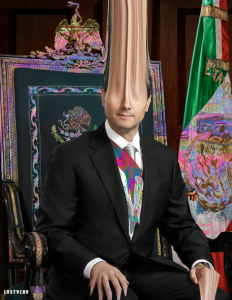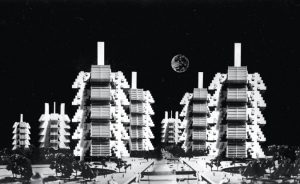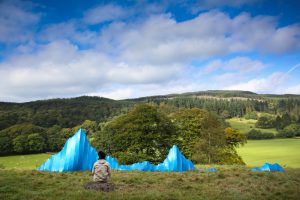Interview with Doreen A. Ríos and Matthew Plummer-Fernandez
Fri 04 Aug 2017This interview was conducted whilst curating My Wall Is Your Filter Bubble, originally commissioned for AND Festival 2017 in Castleton. My Wall Is Your Filter Bubble has gone on to tour internationally. Find out more about our touring work here.
Curating in an Age of Bubbles and Border Politics
Would you like to start by letting us know what My Wall Is Your Filter Bubble is about? What ideas are you addressing with the show and why did you chose to curate an exhibition on this theme?
DR: MWISYFB is an augmented reality exhibition for which we commissioned the creation of six new pieces by six Mexican digital artists. From the very beginning we wanted to create a Mixed Reality exhibition in order to reveal a deeper dialogue between the transition between the digital and the physical. To do so we will geo-locate all the commissioned digital-based pieces into a very specific area inside Castleton.
In this particular case we are focusing on the concept of the filter bubble and how it affects our relationships with others, particularly when it comes to socio-political aspects. We are reacting to the fact that the majority of information online seems to flow one way, from the networked North outwards. We wanted to explore what the implications of this imbalance are. We chose to work with AND festival due to its innovative, open nature and the fact that the village of Castleton itself is defined by its physical characteristics of peaks and caverns, which share, both physically and conceptually, a direct link with the idea of layers that interact above/below/beyond.
MPF: The issue of online ‘filter bubbles’ became increasingly prescient after Brexit and Trump. The digital arts community that I was engaged with voiced concern on these issues, but it was predominantly a Western voice – I was trapped in an echo chamber discussing echo chambers. It felt that a more appropriate response to these issues was to engage with artists further afield and fortuitously I came across Antimateria and the Mexican artists that Doreen supports. The exhibition isn’t designed to be an open bridge between disparate artists and audiences but a faint transmission from afar that demands effort to reach; visitors must still endure a physical hike up hills to get to these artist’s works, and find digital content only accessible once physical locations are reached.
Can you tell us about the artists you’ve chosen to include in the exhibition?
DR: We focused on creating a selection of artists that could provide diverse points of view about the current socio-political situation in Mexico. For instance Arcangelo, born in Mexico City, belongs to the early generations of Mexican artists developing net-art and who has be able to merge various worlds together through the use of biotech, video, and interactive platforms and has been actively involved in social movements; Leslie, born in Tijuana, has a very particular vision about digital communication and language as well as a close relation with the border between the USA and Mexico; Alfredo, born in Mexico city, has a completely different approach to these topics since he’s been living in the USA for a while and his work has always been close to immigration and conceptualizing the idea of a border; Martha, born in Tijuana, is an artist from a younger generation who has focused in the use of glitch as a playful tool for political critique; Diego Ortega, born in Toluca, also an artist from a young generation who focuses on the limits of privacy, identity and the impacts of mass media; and Gibrann, born in Mexico city, who has a deep interest in the creation of speculative environments to engage in contemporary issues. All of them bring a very unique view to the exhibition, it’s very exciting to be working with such amazing artists.

How did you both meet?
DR: Matthew and I met as an act of serendipity. Matthew first approached me via email asking about an open call my platform, Antimateria, had at the time where I was looking for U.K based artists working with alternative media for a show in my hometown, Toluca. We had coffee and started talking about our work, sharing memes and stories and we realised we had a lot of interests in common, especially when it came to Latin American themes.
MPF: Doreen somehow broke the filter bubble by coming to the UK and setting up an Antimateria exhibition at the Winchester School of Art. One of the artworks appeared on one of the Net Art Facebook groups I follow. One browser tab led to another, and within minutes I was emailing Doreen. By the end of our first meeting we were making plans to produce a show together based on the first conversation we had. We discussed how finding each other’s work required overcoming new techno-cultural barriers such as looking beyond search results filtered by language.
What is the visitor journey when coming to the exhibition?
DR: Hopefully we will be able to successfully overlap two layers of reality: the physical one inside Castleton, and the digital one inside an app that will contain the artwork. It will be something like a scavenger hunt for Mexican digital art. Every piece communicates in a unique way with the space and will translate into a geo-located experience enhanced by fusing together these two layers.
MPF: Visitors will be given an iPad running a custom app that guides visitors on a journey through the peaks in search of these virtual artworks. They will walk along virtual borders, tracing informational divides in the landscape. The app itself enables Augmented Reality so that when you view the landscape through the app the artworks appear once these isolated areas have been reached.
In your individual practices, what influences you most in your work?
MPF: The blog Algopop sums up my interest in the increasing influence of software automation in everyday life and culture. I’m also influenced by online culture generally. The issue of filter bubbles has been blamed on algorithmic curation – how recommendation and newsfeed algorithms increasingly deliver online content that fit our individual profiles. Making these algorithmic practices accountable or transparent isn’t my approach; it is preferable to study what social and cultural upshots of algorithmic activity occur, and what else can be imagined under the influence of algorithms.
DR: My background in Architecture has always played a big role in the way I operate as a curator and researcher. The theories towards speculative futures such as the Metabolist Architecture movement or the experimental design of Archigram and various utopian cities have shaped the way I understand digital media. I’m also a big fan of Octavia Butler, Gerardo Arana and Philip K. Dick. My interest towards digital cultures is a consequence of fusing together architecture, technology, and the creation of experiences through space.

What are you reading?
MPF: Sapiens: A Brief History of Humankind, as well as Inheritors of the Earth: How Nature Is Thriving in an Age of Extinction. These books depict humanity as a collective, world-shaping force. My current reading reflects disillusionment with art driven by individualism. This has led me to try to produce works assembled from multiple sources, rather than from a sole author expressing individuality. For my practice I now work on devising software systems that make re-arrangements of other people’s inputs. Curation has become another route for exploring this; there is a lot of scope for an experimental approach to curating groups of artists.
DR: The Internet Does Not Exist and Yes Is More: An Archicomic on Architectural Evolution mainly but I’m also actively going through the discussion board of CRUMB – Curatorial Resource for Upstart Media Bliss.
Doreen, you set up [ANTI]MATERIA, a platform dedicated to the network and promotion of Latin American artists working in the fields of New Media and digital practices. Can you tell us a bit more about the vision for this project?
DR: [ANTI]MATERIA aims to create a space for the research, exhibition and collaboration between artists, curators, researchers and promoters interested in digital cultures. It started with the intention of becoming a genealogy of Mexican digital art but little by little it has transformed into something else. I realised that Latin American artists working with new media and digital art were incredibly underrepresented inside the art circuit. I am aware that there are very interesting platforms with similar objectives such as Furtherfield, Rhizome and even E-flux, yet I wasn’t able to find much information about Latin American practices; that’s how I decided to create it myself. I was already aware that there were very interesting things going on in Mexico, so I started to look further into that and created a strategy that allowed me to provide what I felt was needed. I spent several months getting to know the artists involved in these practices and after asking them what they felt could be improved in order for them to improve their professional careers. [ANTI]MATERIA is a space for sharing, for creating links between professionals interested in digital cultures, for developing multi-directional approaches to digital art and finally, for giving these artists, curators, and researchers the exposure they need to reach new audiences.

Matthew, you often use processes that distort or corrupt the visual language that we have come to expect online. When did you start using these processes? And how do you see them playing out in your work?
MPF: I enjoy things malfunctioning or barely functioning – to escape any air of technological determinism and to allow audiences to react either empathetically or angrily towards the work. I think art driven by technology should be near breaking point; not only does it reflect wider societal frustrations with technology, it is where the most original digital aesthetics emerge.
Feature image credit: The first meme Doreen shared with Matthew was one of the first ever meme in Mexico. This video has been remixed and re enacted countless times since then sparking a discussion about ‘originality’.
Recent Journals
- Introducing AND’s new Associate Board Members
- Introducing AND’s new Board Members
- AND joins Somerset House Studios’ new interdisciplinary programme, n-Space
- Introducing our new Creative Associate Hwa Young Jung
- A Gig at Sunrise: Reflecting on W Brzask at Ephemera Festival
- Announcing our THREE FIELDS artists
- New Rhythms
- Introducing Commons // Keiken and Jazmin Morris
- Introducing our Creative Associates programme
Other Journals
-
2025
-
2024
-
2023
-
2022
-
2021
-
2020
-
2019
-
2018
-
2017
-
2016
-
2015
-
2014
-
2013
-
2012
-
2011



